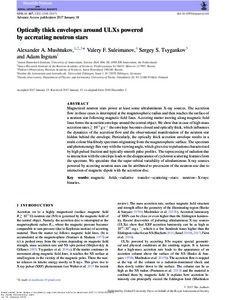Optically thick envelopes around ULXs powered by accreating neutron stars
Alexander A. Mushtukov; Valery F. Suleimanov; Sergey S. Tsygankov; Adam Ingram
Optically thick envelopes around ULXs powered by accreating neutron stars
Alexander A. Mushtukov
Valery F. Suleimanov
Sergey S. Tsygankov
Adam Ingram
OXFORD UNIV PRESS
Julkaisun pysyvä osoite on:
https://urn.fi/URN:NBN:fi-fe2021042716815
https://urn.fi/URN:NBN:fi-fe2021042716815
Tiivistelmä
Magnetized neutron stars power at least some ultraluminous X-ray sources. The accretion flow in these cases is interrupted at the magnetospheric radius and then reaches the surface of a neutron star following magnetic field lines. Accreting matter moving along magnetic field lines forms the accretion envelope around the central object. We show that in case of high-mass accretion rates greater than or similar to 10(19) gs(-1) the envelope becomes closed and optically thick, which influences the dynamics of the accretion flow and the observational manifestation of the neutron star hidden behind the envelope. Particularly, the optically thick accretion envelope results in a multi-colour blackbody spectrum originating from the magnetospheric surface. The spectrum and photon energy flux vary with the viewing angle, which gives rise to pulsations characterized by high pulsed fraction and typically smooth pulse profiles. The reprocessing of radiation due to interaction with the envelope leads to the disappearance of cyclotron scattering features from the spectrum. We speculate that the super-orbital variability of ultraluminous X-ray sources powered by accreting neutron stars can be attributed to precession of the neutron star due to interaction of magnetic dipole with the accretion disc.
Kokoelmat
- Rinnakkaistallenteet [27094]
